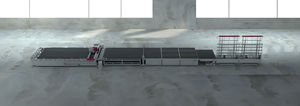
Roller grinding mill ARS-TBX/Yhorizontalglasscompact

Add to favorites
Compare this product
Characteristics
- Technology
- roller
- Orientation
- horizontal
- Product applications
- glass
- Other characteristics
- automatic, compact
Description
The LiSEC float glass breakout system automatically breaks the trim cut at the front, the remnants at the trailing edge, as well as the X and Y sub-plates continuously, quickly and with consistently high breaking edge quality. Thanks to the optionally available electric design of the breaker heads, individual process parameters are possible for each glass type and thickness to deliver even better breakage results for optimum precision and grind additions! Any Z-breakages, remnants and shapes are broken out on a downstream manual breakout table and aligned in the correct position for transfer or unloading.
WHAT ADVANTAGES DOES THIS LINE DELIVER?
Increase in the degree of automation and output of up to 150 sheets per hour
Higher edge quality thanks to electronically controlled breaker heads
Prevention of sheet breakage and grind addition savings
Reduction of costs arising due to wastage
No contact with the coated glass surface
HOW DOES FLOAT GLASS PROCESSING TAKE PLACE?
After break-out, the operator can safely and ergonomically unload the finished glass sheets manually using unloading rollers or tilt arms. Alternatively, the finished glass sheets can be fed to an automatic unloading system by means of a robot or a sorting system consisting of a shuttle and a glass sheet buffer to increase the degree of automation.
HOW ARE SHAPES BROKEN OUT?
Shapes are broken out at the end of the system, after automatic edge, remnant and X-Y break-out of the sub-plate on a manual breakout table with the aid of integrated breaker bars.
Catalogs
No catalogs are available for this product.
See all of LiSEC‘s catalogsRelated Searches
- Grinding mill
- Production machine
- Automatic making machine
- Horizontal grinding mill
- Waste lump breaker
- Roller grinding mill
- Charging machine
- Compact grinding mill
- Continuous production machine
- High-speed production machine
- Profile making machine
- Processing plant
- Automatic grinding mill
- Automated loading system
- Glass grinding mill
- Double making machine
- Glass product production line
- Insulating glass production line
- Glass laminating machine
- Vacuum loading system
*Prices are pre-tax. They exclude delivery charges and customs duties and do not include additional charges for installation or activation options. Prices are indicative only and may vary by country, with changes to the cost of raw materials and exchange rates.





